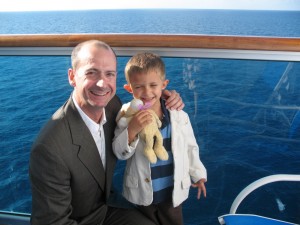I’m reading Conspiracies of Rome by Richard Blake. It’s one of those rare books set in ancient Rome after the western Roman Empire has fallen. The protagonist, Aelric, is a Briton sent to Rome in 609 to make copies of books to benefit the monasteries and church schools in his home country. Upon reaching the old imperial city, he wanders depopulated streets filled with rubble, poverty and faded glory. It’s a fascinating book in its own right, but especially so since I’ve also been reading the Marcus Didius Falco series of books
by Richard Blake. It’s one of those rare books set in ancient Rome after the western Roman Empire has fallen. The protagonist, Aelric, is a Briton sent to Rome in 609 to make copies of books to benefit the monasteries and church schools in his home country. Upon reaching the old imperial city, he wanders depopulated streets filled with rubble, poverty and faded glory. It’s a fascinating book in its own right, but especially so since I’ve also been reading the Marcus Didius Falco series of books by Lindsey Davis, which is set in first-century Rome, when the city was wealthy and functioning.
by Lindsey Davis, which is set in first-century Rome, when the city was wealthy and functioning.

Will a future artist capture the rubble of New York as well as Canaletto portrayed the ruins of Rome? Will the paintings just look like the Rotten Apple in the '70s?
In the Davis books, Falco is explicitly portrayed as a plebeian — a cash-strapped commoner. But the carefully researched stories portray him bathing daily, eating Spanish olive oil and other imported foods, enjoying access to entertainments from around the world and generally living comfortably by historical standards, if not at a 21st century level.
Over five centuries later, Aelric rents rooms at an inn chosen, in part, because it’s one of the rare establishments that still has running water. He walks the same Forum that Falco walked, but sees it packed with mud and filled with broken statues. The temples that Falco once viewed with a cynical eye have been stripped of their marble and gold leaf, the Colosseum that Falco watched being built has already had its heyday and is now abandoned. The sewers are clogged, the aqueducts broken and the population a fraction of its former height, devastated by the long decline and collapse of the West, the city’s reconquest by the now-Constantinople-based empire, disease, invasion …
Although the protagonists in both Blake’s and Davis’s books are fictional characters, I can’t help but imagine the descendants of the first-century Falco and his patrician girlfriend, illiterate, hungry and scratching in the dirt, staring at the visiting barbarian Aelric, himself a descendant of the people who smashed Roman civilization in Britain.
And the contrast between the two visions of Rome inevitably makes we wonder what lies in store for my son, Tony, and his children, and so on. What world will they live in as the generations go forward? Because nothing lasts forever. The country in which I now live will, one day, fall or be pushed aside just as Rome was, suffering the fate of all civilizations. There will, once again, be war, poverty, ignorance …
No, I don’t have a crystal ball. I just have a knowledge of history and how it tends to repeat itself. Of course, my history books will one day lie rotting, just like the scrolls Aelric tries to salvage, and the Internet connection I’m using now will likely suffer the same fate as the Roman aqueducts, which were smashed for tactical advantage and left useless because nobody had the resources to rebuild.
And then, after that, a renaissance will start, as some new civilization rises up.
There’s a fair chance, since I’ve already reproduced, that my descendants will be mixed up in all of that decline, turmoil and rebirth as the generations pass. Does it surprise you to know that I’ve had the 3 a.m. horrors worrying that my great-great-whatever may have to dig through garbage heaps in the ruins?
But that’s always been the case, hasn’t it? The option is to toss the dice and trust your descendants to deal with what life throws their way, or else to bow out of the game entirely. I almost bowed out, but ultimately didn’t. All I can do now is to hand Tony the tools and confidence he’ll need to deal with what comes his way, and hope that he’ll do the same in turn should he have children of his own.
This afternoon, I’m taking him to his Tae Kwon Do class. It’s a small thing, but he enjoys the running and kicking and blocks, even if he has no idea he’s picking up the fundamentals of unarmed self-defense, self-discipline and physical fitness. Lots of small things like that can really add up.
Of course, he’s getting trained to kick my ass, if he ever so desires, so my personal fall may come a little sooner than the next sack of Rome.
If he can take me.





